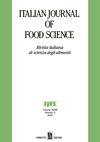熟香肠中霉菌蛋白替代肉类:对氧化稳定性、质地和颜色的影响
IF 3.3
4区 农林科学
Q2 FOOD SCIENCE & TECHNOLOGY
引用次数: 2
摘要
加工肉是世界上消费量最大的产品之一。自然地,动物来源的蛋白质的生产包括成本、能量、时间和环境问题等限制。因此,用真菌蛋白等替代生物材料替代肉类是有前景的。菌丝形态的真菌蛋白,包括分支和长度,与肉类结构紧密,可以作为肉制品的潜在替代品。因此,本研究的主要目的包括用分枝杆菌蛋白完全取代香肠肉,并将新配方的特性与肉的特性进行比较。一般来说,对配方奶粉的理化、微生物、营养和机械特性进行了评估。结果表明,真菌蛋白替代物具有较高的有价值蛋白质和较低的脂质含量,改善了营养和健康效果。此外,与肉肠相比,它含有高含量的必需氨基酸和不饱和脂肪酸。无酵母、霉菌、沙门氏菌。,大肠杆菌和金黄色葡萄球菌在两个样品中验证了热处理的有效性和卫生程序的有效性。在理化性质方面,与牛肉样品相比,含有分枝杆菌蛋白的香肠中更多的水分和脂质含量与其进一步的水结合能力(WBC)(P<0.05)和油结合能力(OBC)有关。此外,与牛肉样品相比,真菌蛋白样品的碳水化合物、灰分和pH值较低(P<0.05)。相比之下,与霉菌蛋白香肠相比,牛肉香肠具有更好的质地特征,如硬度、内聚性、粘性和弹性指数。分枝杆菌蛋白较高的水分和OBC值导致蛋白质间隙的填充以及质地属性的降低。因此,它导致在真菌蛋白制剂中使用更少的油和水。总之,分枝杆菌蛋白可以作为香肠中肉类的合适替代品。本文章由计算机程序翻译,如有差异,请以英文原文为准。
Replacement of meat by mycoproteins in cooked sausages: Effects on oxidative stability, texture, and color
Processed meat is one of the most consumed products worldwide. Naturally, production of proteins with animal origins includes limitations such as costs, energy, time, and environmental problems. Thus, replacement of meats by alternative biomaterials such as mycoproteins can be promising. Mycoproteins with hyphal morphologies, including branches and lengths, have close structures to meat and can be a potential alternative for meat products. Therefore, the major objectives of this study included complete replacement of sausage meats by mycoproteins and comparing characteristics of the novel formula with those of meat. In general, physicochemical, microbial, nutritional, and mechanical characteristics of the formulas were assessed. Results showed that the mycoprotein substitution improved the nutritional and health effects due to the higher valuable protein and lower lipid contents. Besides, it had a high content of essential amino acid and unsaturated fatty acid, compared to meat sausage. Absence of yeasts, molds, Salmonella spp., Eshrichia (E.)coli, and Staphiloccocus (S.)aureus verified the effectiveness of the heat treatment and also the effectiveness of the hygienic procedures in both samples. With regard to phycicochemical properties, more contents of moisture and lipids in sausages containing mycoprotein were linked to further water binding capacity (WBC) (P < 0.05) and oil binding capacity (OBC) in them, compared to beef samples. Besides, the mycoprotein sample had lower (P < 0.05) values of carbohydrates, ash, and pH, compared to the beef sample. In contrast, beef sausages had better textural characteristics, such as hardness, cohesiveness, gumminess, and springiness indexes, compared to mycoprotein sausages. Higher water and OBC values of the mycoproteins led to the filling of the protein interstitial spaces as well as decreasing of the textural attributes. Thus, it resulted in the use of less oil and water in mycoprotein formulations. In conclusion, mycoproteins can be addressed as appropriate replacements for meats in sausages.
求助全文
通过发布文献求助,成功后即可免费获取论文全文。
去求助
来源期刊

Italian Journal of Food Science
工程技术-食品科技
CiteScore
4.20
自引率
0.00%
发文量
33
审稿时长
>36 weeks
期刊介绍:
"Italian Journal of Food Science" is an international journal publishing original, basic and applied papers, reviews, short communications, surveys and opinions on food science and technology with specific reference to the Mediterranean Region. Its expanded scope includes food production, food engineering, food management, food quality, shelf-life, consumer acceptance of foodstuffs, food safety and nutrition, energy and environmental aspects of food processing on the whole life cycle.
Reviews and surveys on specific topics relevant to the advance of the Mediterranean food industry are particularly welcome.
 求助内容:
求助内容: 应助结果提醒方式:
应助结果提醒方式:


